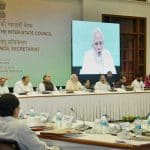Every year, Assam, the largest state in northeastern India is damaged by floods. Thousands of people are displaced and property worth billions of dollars are destroyed. The past few years have seen a rapid destruction of infrastructure and biodiversity areas in Assam due to floods. But, it seems, hardly and lessons are learnt.
Causes
- Though natural topography and heavy rainfall are obvious causes, floods are also caused by human interference like the encroachment of river banks and wetlands, lack of drainage, unplanned urban growth, cutting of hills and deforestation.
- The Brahmaputra is the world’s 6th largest river in terms of water carrying capacity.
- It is a trans-boundary river with a total length of 2,906 km. 918 km of the river flows through India, which includes 640 km flowing through Assam. It is braided and unstable in its entire reach in Assam except for a few places.
- The river has 41 tributaries, with 26 flowing in the North bank and 15 in the South bank.
- Heavy rains in Arunachal Pradesh, Bhutan and Upper Assam make the Brahmaputra and its tributaries to flow above their danger mark. The excess water breaks embankments in many places causing severe floods along the route, especially in regions of Lower Assam.
- More than 80% of these embankments are not rebuilt because there is a huge contractor-administration nexus that benefits monetarily from a flood situation.
- According to a report, the main reasons behind the instability of the river are high sedimentation and steep slopes.
- Drainage congestion due to the building of railway bridges, roads and culverts have restricted the natural flow of waters, forcing it to back flow and break embankments in vulnerable areas.
- Also, the entire area falls in an earthquake-prone zone and experiences high rainfall.
- The dams built across the river are further creating disasters. Not just that, the wetlands forests and local water bodies are being systematically destroyed which in turn is adding to the disaster vulnerability of the area.
About the Brahmaputra board
- The Brahmaputra board is a central government body.
- It carries out surveys and investigations in the Brahmaputra Valley and prepares a master plan for the control of floods, bank erosion and improvement of drainage.
2017 floods
- As per the data released by the Assam State Disaster Management Authority (ASDMA), 2017 has been the worst of the last four years in terms of floods.
- This year, about 2,450 villages have been already affected by floods and more than 1.7 million people across the districts of Lakhimpur, Biswanath, Karimganj, Kokrajhar, among others, displaced. The monsoon season is still ongoing.
- ASDMA has set up 123 relief camps and 259 relief distribution centres across the state but the number of displaced is increasing.
- The camps are housing close to 29,000 refugees.
What are the problems?
- As per the National Flood Commission of India, Brahmaputra valley is one of the most hazard-prone regions. Despite setting up various flood management committees and bodies such as Central Water Commission (CWC) set up in 1945, Brahmaputra Board set up in 1980, Ganga Flood Control Mission formed in 1972 and the National Disaster State Management Authority constituted in 2005, their role in effective flood control remains unclear and efficient management of floods still remains a distant reality.
- Programmes such as FLEWS (Flood Early Warning System), which sought to provide early warnings about floods in magnitude, region and probable time, seem to have been ineffective in securing the response to floods.
- Floods are a cause of worry for the administration as they spread disease.
- Japanese Encephalitis and other water-borne diseases such as jaundice and cholera can affect the refugee camps because there are too many displaced people.
- During floods, lack of clean drinking water is the biggest problem.
- The primary cause of the repeated damage by floods, is what experts believe, the fault in the structures that are meant to control the flood.
- The embankments along the Brahmaputra and its tributaries, which were built on the basis of the 1954 recommendations of the Rashtriya Barh Ayog have shown signs of ageing, a report in The Indian Express stated. The problem in the structures is that they were built keeping in mind two decade-old flood data, which is starkly different from the current data.
- The lack of research in the area of flood control contributes to worsening the perennial aftermath of floods.
- RTIs filed by The Quint reveal that the Environment Ministry has spent less than half a percent of its already dipping annual budget on research. From 2012-2013 to 2016-2017, the average percent of the budget spent on research is 0.24 percent.
Solutions
- Authorities should improve the flood forecasting system and coordinate with local administrations.
- The central water commission (CWC) puts out flood forecasts but that is not good enough as the local administration is not able to use it. CWC also needs to take into account rainfall data and not just upstream water flow. All such measures along with addressing man made causes can help reduce the level of disaster in the region.
- The failure of preventive measures, the slow response of government authorities, and the absence of effective plans to mitigate floods demonstrate an urgent need to reevaluate strategies concerning the same.
- There is a growing need of proactive efforts on part of the government to enhance the quality of response to environmental concerns affecting millions across the country.
- Between 2012-2013 and 2016-2017, the government budget for environment has been slashed by 19 percent. This clearly shows the nature of government reaction to the issue of environment and sustainability.
Note: Want to share this story with someone? Just click on the icons below.











